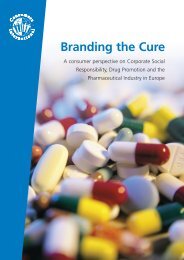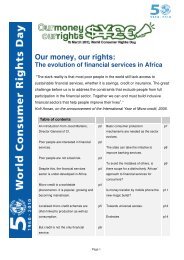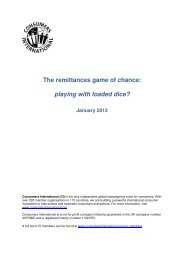Voices for Change: the Consumer Right to Representation
Voices for Change: the Consumer Right to Representation
Voices for Change: the Consumer Right to Representation
Create successful ePaper yourself
Turn your PDF publications into a flip-book with our unique Google optimized e-Paper software.
World <strong>Consumer</strong> <strong>Right</strong>s Day 2002: <strong>Voices</strong> <strong>for</strong> <strong>Change</strong><br />
One important issue is whe<strong>the</strong>r representation<br />
is by a dedicated consumer body made up of<br />
a number of members, or by consumer representatives<br />
sitting on a body alongside people<br />
representing o<strong>the</strong>r interests. Which is most<br />
effective depends on <strong>the</strong> particular situation.<br />
A closely related issue is whe<strong>the</strong>r consumer<br />
representatives are a minority or majority on<br />
such bodies. Poorly supported lone<br />
consumers on committees full of government<br />
and industry experts can be intimidated and<br />
have little chance <strong>to</strong> be effective.<br />
In some cases, members or staff of consumer<br />
organisations fill representative roles.<br />
Elsewhere, <strong>the</strong> government or industry body<br />
appoints individuals, sometimes with open<br />
invitations <strong>to</strong> <strong>the</strong> public <strong>to</strong> apply and <strong>for</strong>mal<br />
selection procedures. Continuous liaison<br />
between different groups within <strong>the</strong> consumer<br />
movement, and with o<strong>the</strong>r NGOs, is often<br />
important <strong>to</strong> provide in<strong>for</strong>mation and support<br />
<strong>for</strong> representatives. Conversely, rivalry<br />
between groups seeking <strong>to</strong> play a<br />
representative role can be destructive.<br />
To be effective, consumer representatives need<br />
<strong>to</strong> have clear powers <strong>to</strong> influence policy and<br />
<strong>the</strong> right <strong>to</strong> challenge decisions. They need<br />
access <strong>to</strong> in<strong>for</strong>mation and resources. Ideally,<br />
dedicated consumer committees and councils<br />
need <strong>to</strong> be supported by staff and have a<br />
budget <strong>to</strong> conduct <strong>the</strong>ir own research and<br />
consultation among ordinary consumers.<br />
<strong>Consumer</strong> representatives should also have<br />
defined duties – <strong>to</strong> conduct <strong>the</strong>ir work<br />
transparently and openly, <strong>to</strong> preserve <strong>the</strong>ir<br />
independence and <strong>to</strong> represent consumers as<br />
well as <strong>the</strong>y can. Individual representatives<br />
should be remunerated at an appropriate level<br />
<strong>for</strong> <strong>the</strong>ir time. Often individual representatives<br />
are more effective if <strong>the</strong>y receive training <strong>to</strong><br />
sharpen <strong>the</strong>ir skills and knowledge relevant <strong>to</strong><br />
<strong>the</strong> subjects <strong>the</strong>y are dealing with.<br />
Model 2: Formal open consultation<br />
This model involves <strong>for</strong>mal, open processes of<br />
consultation on specific policy issues. Typically,<br />
a consultation document is published<br />
containing proposals or options, and responses<br />
are invited from any individual or organisation<br />
that wants <strong>to</strong> comment. The subjects range<br />
from government, regula<strong>to</strong>ry and industry<br />
policy on consumer issues <strong>to</strong> plans <strong>for</strong> land<br />
use, public amenity developments and changes<br />
in systems <strong>for</strong> local democracy.<br />
The practicalities also vary. Publication can be<br />
by specially printed consultation papers made<br />
available on request, documents sent <strong>to</strong><br />
people in <strong>the</strong>ir homes, leaflets made available<br />
in public buildings, and pages on <strong>the</strong> web.<br />
Fur<strong>the</strong>r publicity and “outreach” can be<br />
achieved by public exhibitions, use of <strong>the</strong><br />
mass media and by requests <strong>to</strong> consumer<br />
organisations and o<strong>the</strong>r NGOs <strong>to</strong> respond <strong>to</strong><br />
<strong>the</strong> consultation. Meetings of interested<br />
parties are sometimes arranged <strong>to</strong> clarify<br />
responses, particularly from key recognised<br />
trade bodies and consumer organisations.<br />
Usually <strong>the</strong>re is a time limit <strong>for</strong> responses.<br />
It is good practice <strong>for</strong> <strong>the</strong> decision-making<br />
body <strong>to</strong> publish a summary account of <strong>the</strong><br />
consultation responses alongside its<br />
eventual decisions.<br />
<strong>Consumer</strong> organisations find that responding<br />
<strong>to</strong> open consultation is a useful way of<br />
influencing policy. One great advantage <strong>for</strong><br />
NGOs is that <strong>the</strong>y can choose <strong>to</strong> respond at<br />
whatever length and at whatever level of<br />
detail that <strong>the</strong>y see fit. NGOs can thus<br />
respond <strong>to</strong> a wide range of consultations,<br />
concentrating resources on those that <strong>the</strong>y see<br />
as high priority, while producing briefer and<br />
less detailed responses <strong>for</strong> lower-priority<br />
subjects. This leaves <strong>the</strong> NGO with greater<br />
control of <strong>the</strong> resources devoted <strong>to</strong> a<br />
particular subject than is generally <strong>the</strong> case<br />
when <strong>the</strong>y sit on committees governed by<br />
more rigid agendas and work plans. However,<br />
this relationship is clearly defined as<br />
consultation ra<strong>the</strong>r than negotiation: <strong>the</strong><br />
exercise is usually a trawl <strong>for</strong> views from all<br />
interest groups, and all <strong>the</strong> power <strong>to</strong> make <strong>the</strong><br />
decision rests with <strong>the</strong> original authority.<br />
An even more <strong>for</strong>mal version of open<br />
consultation involves public enquiries and<br />
hearings, where groups representing <strong>the</strong><br />
interested parties present evidence. Resources<br />
are required <strong>for</strong> <strong>the</strong> consumer voice <strong>to</strong> be<br />
heard at <strong>the</strong>se hearings – sometimes <strong>to</strong> fund<br />
legal assistance. One advantage of this<br />
method of consultation is that more of <strong>the</strong><br />
arguments are played out in public.<br />
19






![pkef]Qmf eg]sf] s] xf] < - Consumers International](https://img.yumpu.com/6479658/1/184x260/pkefqmf-egsf-s-xf-consumers-international.jpg?quality=85)
